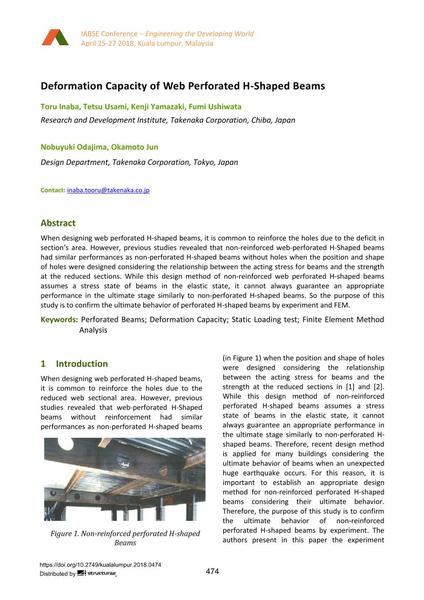Deformation Capacity of Web Perforated H-Shaped Beams

|
|
|||||||||||
Bibliografische Angaben
| Autor(en): |
Toru Inaba
(Research and Development Institute, Takenaka Corporation, Chiba, Japan)
Tetsu Usami (Research and Development Institute, Takenaka Corporation, Chiba, Japan) Kenji Yamazaki (Research and Development Institute, Takenaka Corporation, Chiba, Japan) Fumi Ushiwata (Research and Development Institute, Takenaka Corporation, Chiba, Japan) Nobuyuki Odajima (Design Department, Takenaka Corporation, Tokyo, Japan) Okamoto Jun (Design Department, Takenaka Corporation, Tokyo, Japan) |
||||
|---|---|---|---|---|---|
| Medium: | Tagungsbeitrag | ||||
| Sprache(n): | Englisch | ||||
| Tagung: | IABSE Conference: Engineering the Developing World, Kuala Lumpur, Malaysia, 25-27 April 2018 | ||||
| Veröffentlicht in: | IABSE Conference Kuala Lumpur 2018 | ||||
|
|||||
| Seite(n): | 474-481 | ||||
| Anzahl der Seiten (im PDF): | 8 | ||||
| DOI: | 10.2749/kualalumpur.2018.0474 | ||||
| Abstrakt: |
When designing web perforated H-shaped beams, it is common to reinforce the holes due to the deficit in section’s area. However, previous studies revealed that non-reinforced web-perforated H-Shaped beams had similar performances as non-perforated H-shaped beams without holes when the position and shape of holes were designed considering the relationship between the acting stress for beams and the strength at the reduced sections. While this design method of non-reinforced web perforated H-shaped beams assumes a stress state of beams in the elastic state, it cannot always guarantee an appropriate performance in the ultimate stage similarly to non-perforated H-shaped beams. So the purpose of this study is to confirm the ultimate behavior of perforated H-shaped beams by experiment and FEM. |
||||
| Stichwörter: |
Verformungskapazität
|
||||
